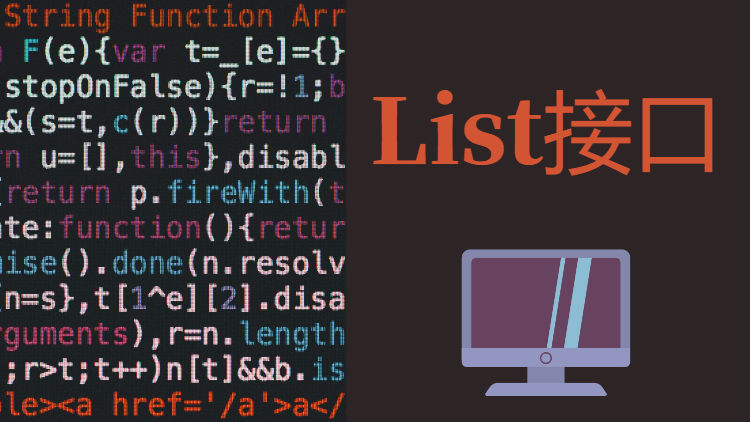2、List接口
List接口
1、List接口的基本介绍
-
List 接口是 Collection 接口的子接口
-
List集合类中元素有序(既添加顺序和取出顺序一致)、且可重复
List list = new ArrayList(); list.add("jack"); list.add("tom"); list.add("mary"); list.add("hap"); list.add("tom"); System.out.println(list); //[jack, tom, mary, hap, tom] -
List集合中的每个元素都有其对应的顺序索引,即支持索引
-
List容器中的元素都对应一个整数型的序号记载其在容器中的位置,可以根据序号存取容器中的元素
-
JDK API 中的List接口的实现类有:AbstractList , AbstractSequentialList , ArrayList , AttributeList , CopyOnWriteArrayList , LinkedList , RoleList , RoleUnresolvedList , Stack , Vector
常用的有:ArrayList 、LinkedList 、Vector
-
2、List接口的常用方法
- void add(int index, Object ele): 在index位置插入ele元素
- boolean addAll(int index, Collection eles) :从index位置开始将eles中的所有元素添加进来
- Object get(int index) :获取指定index位置的元素
- int indexOf(Object obj) : 返回obj在集合中首次出现的位置
- int lastIndexOf(Object obj) : 返回obj在当前集合中末次出现的位置
- Object remove(int index):移除指定index位置的元素,并返回次元素
- Object set(int index, Object ele):设置指定index位置的元素为ele,相当于是替换
- List subList(int fromIndex, int toIndex):返回从fromIndex到toIndex位置的子集合 (左闭右开)
List list = new ArrayList();
list.add("张三丰");
list.add("贾宝玉");
list.add(1,"杨过");
System.out.println(list); //[张三丰, 杨过, 贾宝玉]
List list2 = new ArrayList();
list2.add("jack");
list2.add("tom");
list.addAll(1,list2);
System.out.println(list); //[张三丰, jack, tom, 杨过, 贾宝玉]
Object o = list.get(2);
System.out.println(o); //tom
System.out.println(list.indexOf("tom")); //2
list.add("杨过");
System.out.println(list); //[张三丰, jack, tom, 杨过, 贾宝玉, 杨过]
System.out.println(list.lastIndexOf("杨过")); //5
list.remove(0);
System.out.println(list); //[jack, tom, 杨过, 贾宝玉, 杨过]
list.set(1,"玛丽");
System.out.println(list); //[jack, 玛丽, 杨过, 贾宝玉, 杨过]
List returnList = list.subList(0, 2);
System.out.println(returnList); //[jack, 玛丽]
3、List三种遍历方式
package com.hspedu.list_;
import java.util.*;
public class ListFor {
public static void main(String[] args) {
//List 接口的实现子类 Vector LinkedList
//List list = new ArrayList();
List list = new LinkedList();
//List list = new Vector();
list.add("jack");
list.add("tom");
list.add("鱼香肉丝");
list.add("北京烤鸭子");
//遍历
Iterator iterator = list.iterator();
while (iterator.hasNext()) {
Object obj = iterator.next();
System.out.println(obj);
}
for (Object obj2 : list) {
System.out.println(obj2);
}
for (int i = 0; i < list.size(); i++) {
System.out.println(list.get(i));
}
}
}
4、ArrayList的注意事项
-
permits all elements, incuding null, ArrayList 可以加入null,并且多个
ArrayList arrayList = new ArrayList(); arrayList.add(null); arrayList.add("jack"); arrayList.add(null); System.out.println(arrayList); //[null, jack, null] -
ArrayList是由数组来实现数据存储的
-
ArrayList基本等同于Vector,除了ArrayList是线程不安全(执行效率高),在多线程情况下,不建议使用ArrayList
5、ArrayList底层结构和源码分析
- ArrayList中维护了一个Object类型的数组elementData。 transient Object[] elementData; //transient 表示瞬间,短暂的,表示该属性不会被序列化
- 当创建ArrayList对象时,如果使用的是无参构造器,则初始elementData容量为0,第1次添加,则扩容elementData为10,如需要再次扩容,则扩容elementData为1.5倍。
- 如果使用的是指定大小的构造器,则初始elementData容量为指定大小,如果需要扩容,则直接扩容elementData为1.5倍。
6、 Vectord底层结构和源码分析
-
Vector类的定义说明
public class Vector<E> extends AbstractList<E> implements List<E>, RandomAccess, Cloneable, java.io.Serializable -
Vector底层也是一个对象数组,protected Object[] elementData;
-
Vector 是线程同步的,即线程安全,Vector类的操作方法带有synchronized
public synchronized E get(int index) { if (index >= elementCount) throw new ArrayIndexOutOfBoundsException(index); return elementData(index); } -
在开发中,需要线程同步安全性,考虑使用Vector
7、Vector和ArrayList的比较
| 底层结构 | 版本 | 线程安全(同步)效率 | 扩容倍数 | |
|---|---|---|---|---|
| ArrayList | 可变数组 | jdk1.2 | 不安全,效率高 | 如果有参构造1.5倍 如果是无参 1.第一次10 2.从第二次开始按1.5扩 |
| Vector | 可变数组 | jdk1.0 | 安全,效率不高 | 如果是无参,默认10,满后,就按2倍扩容 如果指定大小,则每次直接按2倍扩 |
8、LinkedList底层结构
- LinkedList的全面说明
- LinkedList底层实现了双向链表和双端队列特点
- 可以添加任意元素(元素可以重复),包括null
- 线程不安全,没有实现同步
- LinkedList的底层操作机制
- LinkedList底层维护了一个双向链表
- LinkedList中维护了两个属性first和last分别指向首节点和尾节点
- 每个节点(Node对象),里面又维护了prev、next、item三个属性,其中通过prev指向前一个,通过next指向后一个节点。最终实现双向链表
- 所以LinkedList的元素的添加和删除,不是通过数组完成的,相对来说效率较高
public class LinkedList01 {
public static void main(String[] args) {
//模拟一个简单的双向链表
Node jack = new Node("jack");
Node tom = new Node("tom");
Node hsp = new Node("老汉");
//连接三个结点,形成双向链表
jack.next = tom;
tom.next = hsp;
hsp.pre = tom;
tom.pre= jack;
Node first = jack; //让first引用指向jack,就是双向链表的头结点
Node last = hsp; //让last引用指向hsp,就是双向链表的尾结点
//演示,从头到尾进行遍历
while (true) {
if (first == null) {
break;
}
//输出first 信息
System.out.println(first);
first = first.next;
}
//演示,从尾到头进行遍历
System.out.println("=======================");
while (true) {
if (last == null) {
break;
}
//输出first 信息
System.out.println(last);
last = last.pre;
}
//演示链表的添加对象/数据,是多么的方便
//要求,是在 tom ------ 老汉 之间,插入一个对象 smith
//1. 先创建一个 Node 结点, name 就是 smith
Node smith = new Node("smith");
smith.next = hsp;
smith.pre = tom;
hsp.pre = smith;
tom.next = smith;
//让first 再次指向jack
first = jack;
System.out.println("=======================");
while (true) {
if (first == null) {
break;
}
//输出first 信息
System.out.println(first);
first = first.next;
}
}
}
//定义一个Node类,Node对象 表示双向链表的一个结点
class Node {
public Object item; //真正存放数据
public Node next; //指向后一个结点
public Node pre; //指向前一个结点
public Node(Object name) {
this.item = name;
}
public String toString() {
return "Node name " + item;
}
}
/*
运行结果:
Node name jack
Node name tom
Node name 老汉
=======================
Node name 老汉
Node name tom
Node name jack
=======================
Node name jack
Node name tom
Node name smith
Node name 老汉
*/
9、ArrayList和LinkedList的比较
| 底层结构 | 增删的效率 | 改查的效率 | |
|---|---|---|---|
| ArrayList | 可变数组 | 较低,数组扩容 | 较高 |
| LinkedList | 双向链表 | 较高,通过链表追加 | 较低 |
- 如何选择ArrayList和LinkedList:
- 如果我们改查的操作多,选择ArrayList
- 如果我们增删的操作多,选择LinkedList
- 一般来说,在程序中,80% - 90%都是查询,因此大部分情况下会选择ArrayList
- 在一个项目中,根据业务灵活选择,也可能这样,一个模块使用的是ArrayList,另外一个模块使用的是LinkedList

 List接口
List接口


【推荐】国内首个AI IDE,深度理解中文开发场景,立即下载体验Trae
【推荐】编程新体验,更懂你的AI,立即体验豆包MarsCode编程助手
【推荐】抖音旗下AI助手豆包,你的智能百科全书,全免费不限次数
【推荐】轻量又高性能的 SSH 工具 IShell:AI 加持,快人一步
· 分享一个免费、快速、无限量使用的满血 DeepSeek R1 模型,支持深度思考和联网搜索!
· 25岁的心里话
· 基于 Docker 搭建 FRP 内网穿透开源项目(很简单哒)
· ollama系列01:轻松3步本地部署deepseek,普通电脑可用
· 闲置电脑爆改个人服务器(超详细) #公网映射 #Vmware虚拟网络编辑器